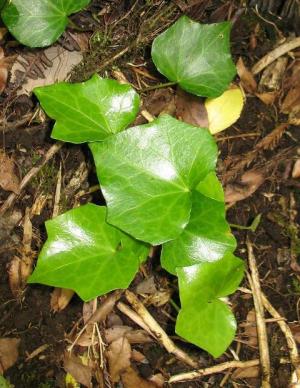Azores ivy

Azores Ivy is a woody, evergreen, climbing or ground-creeping vine of the genus Hedera, in the family Araliaceae. Like other members within the genus, this plant has distinctive juvenile and adult life stages. In the juvenile stage, the plant will have characteristically lobed leaves and exhibit herbaceous growth to form dense patches on the ground. The transition from juvenile to adult is triggered by the climbing of a host structure, such as a fence, wall, or tree. At this point the plant will develop woody vines, the leaves will transition from lobed to unlobed and the plant will eventually begin to produce umbels of small flowers on secondary branches.
Ivy is probably best known for its use in landscape decoration and in 2010 it was estimated that 8 million potted plants were sold in the US alone. Ivy is not a newcomer to field of decorative landscaping, having been used for this purpose for at least the last 300 years. During which a remarkable diversity of cultivars has been developed. Ivy, generically (Hedera Spp.) is considered native to western, central and southern Europe, Macaronesia, northwestern Africa and across central-southern Asia east to Japan and Taiwan
All species within the genus should be considered toxic, as they can cause a negative physical reaction when ingested or when they make contact with unprotected skin. The primary toxins are triterpenoid saponins (hederasaponin C, hederasaponin B, hederasaponoside B and C) and the polyacetylene terpenoid, falcarinol. A polyyne; falcarinol is capable of inducing a relatively severe allergic reaction (contact dermatitis) to the skin of some individuals and animals. The reflex expectorant effect of saponins has also helped the plant find use by some individuals in the holistic community for the treatment of dry cough.
Like many species of potentially harmful plant the actual toxicity or lethality of ivy (regardless of species) seems to have been greatly exaggerated. In Poisonous plants in Britain and their effects on animals and man (1984), authors Cooper, M. R. and Johnson, A. W note that “Cattle that ingested large quantities of English ivy vine became ill and excitable, started staggering, and bellowed loudly. The odor of crushed ivy leaves was on the breath and in the milk. Recovery was quick and complete in three days”. Additionally this author was unable to find a single fatality, human, animal or otherwise caused by the ingestion of any species in the genus Hedera. In fact most reputable scientific and medical sources point out that the primary effect of ingestion seems to be limited to irritation of the digestive tract that manifests as vomiting and/or diarrhea. The most commonly reported symptoms are vomiting, coughing, and oral irritation. Hederin, one of the saponins isolated from the leaves of Hedera spp., is a strong and near immediate irritant of the mucous membranes of the nose and throat. This tends to dissuade all but the most stubborn of animals from consuming anything more than a negligible amount of the plant. However, even with a small ingestion there is still a risk of allergic and irritant contact dermatitis of the oral mucosa due to the polyacetylene compound; falcarinol. The associated discomfort which can include blisters in the mouth and throat could make eating or drinking a near impossibility for a few days necessitating the use of intravenous fluids to maintain adequate hydration.
Avoid further ingestion of the plant and consult a veterinarian. Life threatening intoxication is exceedingly rare, fatalities, while theoretically possible are basically unheard of. As per the case histories and documentation that is available the most serious threat is likely posed by the possibility of an extreme allergic reaction to the plants irritant toxin, falcarinol. In regards to a specific treatment regimen, common sense symptomatic care will probably be all that is required. If the ingestion was recent remove any existing plant matter from the mouth and flush thoroughly with water. If vomiting does not occur it may be induced by giving and emetic such as 3% hydrogen peroxide orally at a dose rate of 1 teaspoon per 10 lbs of body weight. The pet will more than likely start vomiting spontaneously without the help of an emetic, as their body tries to expel this non digestible material. The universal antidote, activated medical charcoal may also prove to be of some use in absorbing the toxins.
Ensure the pet gets plenty of fluids to avoid possible dehydration caused by diarrhea. To alleviate the gastrointestinal upset and diarrhea; Kapectolin may be given at a dose rate of 1 to 2 ml/kg four times a day. Kapectolin provides a coating action that protects the stomach lining. Sucralfate may also be used as for gastrointestinal irritation as it reacts with the acids in the stomach to form a paste-like material capable of acting as a barrier between the stomach and its contents. Sucralfate is typically given to dogs weighing more the 60lbs: 1g every 6 to 8 hours; for dogs under 60 lbs: 0.5g every 6 to 8 hours; Cats: 0.25g every 8 to 12 hours to reduce irritation of the stomach and intestines. The prognosis will depend on the amount ingested and the resultant severity of the intoxication. Serious intoxications of animals are exceptionally rare and in most cases symptoms will be limited to gastrointestinal upset (vomiting and diarrhea). With symptomatic care most animals will make a full recovery in a few hours to a few days.




